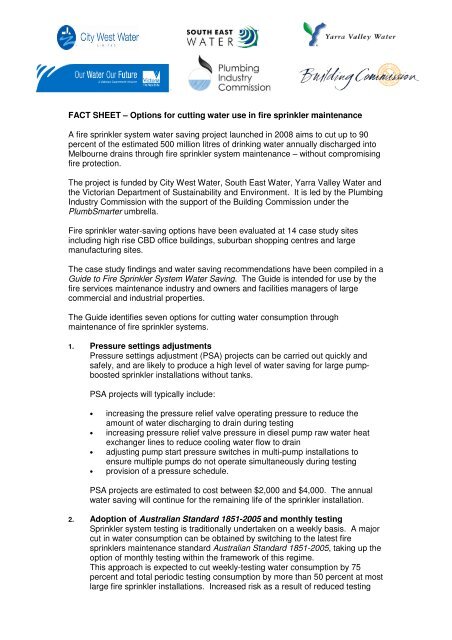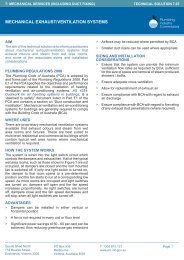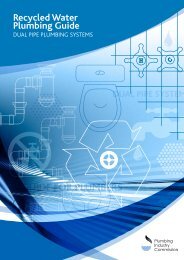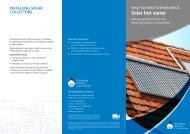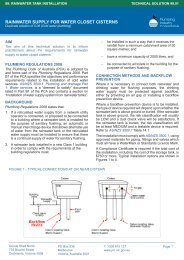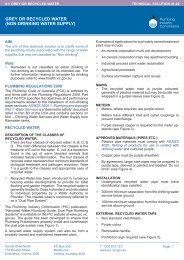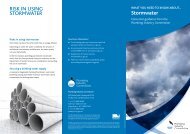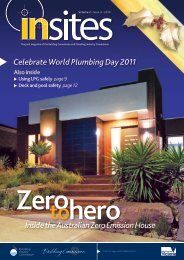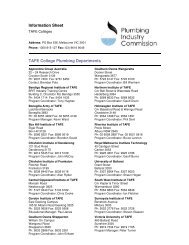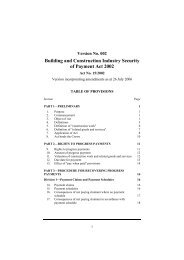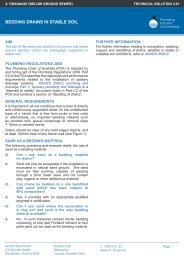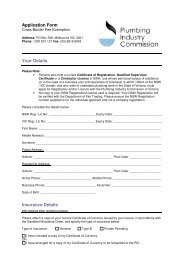FACT SHEET - Plumbing Industry Commission
FACT SHEET - Plumbing Industry Commission
FACT SHEET - Plumbing Industry Commission
You also want an ePaper? Increase the reach of your titles
YUMPU automatically turns print PDFs into web optimized ePapers that Google loves.
<strong>FACT</strong> <strong>SHEET</strong> – Options for cutting water use in fire sprinkler maintenance<br />
A fire sprinkler system water saving project launched in 2008 aims to cut up to 90<br />
percent of the estimated 500 million litres of drinking water annually discharged into<br />
Melbourne drains through fire sprinkler system maintenance – without compromising<br />
fire protection.<br />
The project is funded by City West Water, South East Water, Yarra Valley Water and<br />
the Victorian Department of Sustainability and Environment. It is led by the <strong>Plumbing</strong><br />
<strong>Industry</strong> <strong>Commission</strong> with the support of the Building <strong>Commission</strong> under the<br />
PlumbSmarter umbrella.<br />
Fire sprinkler water-saving options have been evaluated at 14 case study sites<br />
including high rise CBD office buildings, suburban shopping centres and large<br />
manufacturing sites.<br />
The case study findings and water saving recommendations have been compiled in a<br />
Guide to Fire Sprinkler System Water Saving. The Guide is intended for use by the<br />
fire services maintenance industry and owners and facilities managers of large<br />
commercial and industrial properties.<br />
The Guide identifies seven options for cutting water consumption through<br />
maintenance of fire sprinkler systems.<br />
1. Pressure settings adjustments<br />
Pressure settings adjustment (PSA) projects can be carried out quickly and<br />
safely, and are likely to produce a high level of water saving for large pumpboosted<br />
sprinkler installations without tanks.<br />
PSA projects will typically include:<br />
• increasing the pressure relief valve operating pressure to reduce the<br />
amount of water discharging to drain during testing<br />
• increasing pressure relief valve pressure in diesel pump raw water heat<br />
exchanger lines to reduce cooling water flow to drain<br />
• adjusting pump start pressure switches in multi-pump installations to<br />
ensure multiple pumps do not operate simultaneously during testing<br />
• provision of a pressure schedule.<br />
PSA projects are estimated to cost between $2,000 and $4,000. The annual<br />
water saving will continue for the remaining life of the sprinkler installation.<br />
2. Adoption of Australian Standard 1851-2005 and monthly testing<br />
Sprinkler system testing is traditionally undertaken on a weekly basis. A major<br />
cut in water consumption can be obtained by switching to the latest fire<br />
sprinklers maintenance standard Australian Standard 1851-2005, taking up the<br />
option of monthly testing within the framework of this regime.<br />
This approach is expected to cut weekly-testing water consumption by 75<br />
percent and total periodic testing consumption by more than 50 percent at most<br />
large fire sprinkler installations. Increased risk as a result of reduced testing
frequency is counter-balanced by other safeguards introduced under the<br />
maintenance regime.<br />
3. Pressure reducing projects<br />
Reducing pressure in pumps that over-pressurise can save millions of litres of<br />
water consumed in weekly testing of fire sprinkler systems. Pressure reducing<br />
projects on pump boosted sites may include decreasing pump speed,<br />
decreasing the size of the pump impellor or installing pressure reducing valves.<br />
4. Recirculation of fire sprinkler water<br />
An alternative to draining thousands of litres of water is to recirculate fire<br />
sprinkler test water. Water needed to test the operational readiness of a fire<br />
sprinkler system can be drawn from a tank and recirculated during the test.<br />
Incorporating a tank and recirculation will be particularly effective when there<br />
are pressure relief valves in pumping systems and they discharge directly into<br />
drains. It is estimated that installing a 10,000 litre recirculation tank with<br />
connections to the system will cost between $40,000 and $60,000.<br />
5. Recycling fire sprinkler water<br />
The water discharged after fire sprinkler testing cannot be treated as drinking<br />
quality water but it can be captured and reused for the sprinkler system or put<br />
to other uses such as urban irrigation, cooling towers, toilets or car washing.<br />
Recycled fire sprinkler water can become part of a property’s large water<br />
capture and re-use system that may also include rainwater, stormwater or<br />
greywater.<br />
6. Better zoning of fire sprinkler installations<br />
Fire sprinkler system water consumption can be cut through improved<br />
draindown zoning where draindown water is captured in a tank and drawn on<br />
for recharging the system. Zoning enables portions of a sprinkler system to be<br />
isolated while major refurbishment of a building or modification to a system is<br />
being undertaken.<br />
Draindown consumption is a significant water saving opportunity for large to<br />
medium shopping centres, including centres that do not have pump-boosted<br />
systems, and for high rise building renovation projects.<br />
7. Better management of fire sprinkler draindowns and recharging<br />
If zoning is not provided, better draindown management will be an effective tool<br />
in reducing water consumption at properties subject to frequent draindowns.<br />
By efficiently managing sprinkler installation draindowns through the<br />
development of strong drain management systems, water use and pollution can<br />
be reduced. This may supplement and or replace the need to install valves to<br />
zone sprinkler installations.<br />
The complete Guide to Fire Sprinkler System Water Saving is available through the<br />
<strong>Plumbing</strong> <strong>Industry</strong> <strong>Commission</strong> website www.pic.vic.gov.au.<br />
For further information contact Haydn Wood at the Building <strong>Commission</strong> on 03 9285<br />
6438 or email hwood@buildingcommission.com.au.<br />
2


